Brackenridgea zanguebarica
Brackenridgea zanguebarica Oliv.
Family: Ochnaceae
Common names: yellow peeling plane (Eng.); geellekkerbreek (Afr.); mutavhatsindi (Ven.)
SA Tree No: 483.1
Introduction
The yellow peeling plane, better known as mutavhatsindi, is one of the most sought-after trees in South Africa, particularly within the Vhembe District Municipality in Limpopo. It is highly sought-after for its traditional medicinal use and cultural magical use.
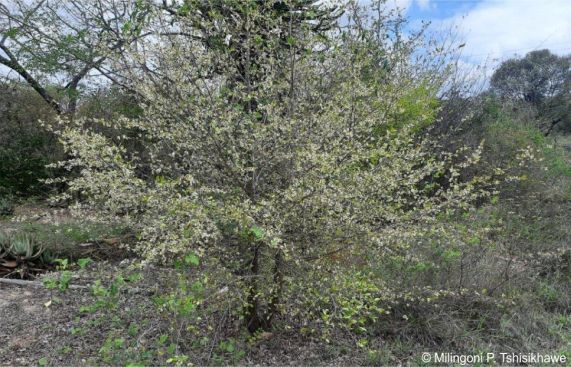
Description
Description
Brackenridgea zanguebarica is a small to medium-sized tree or shrub that grows up to 5 m high and 3 m wide, occasionally taller up to about 10 m. It is a single-stemmed tree unless disturbed, with greyish-brown, corky, rough bark that has a distinctive yellow pigment underneath the bark when scratched, with longitudinal ridges. The leaves are simple, elliptic to obovate, approximately 40-50 mm long, glossy dark green above and pale green below, hairless, margins serrated or finely toothed, the midrib slightly protruding with lateral vein prominent, and a pointed apex.
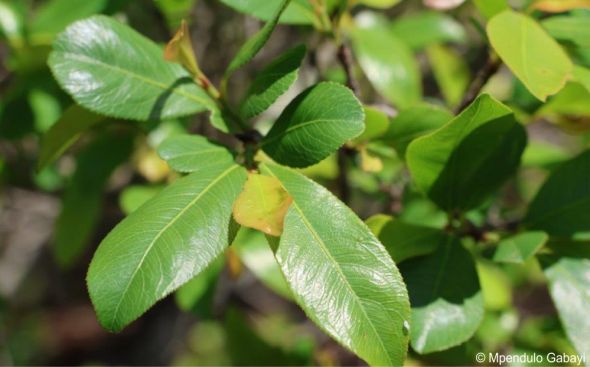
Flowers and fruit resemble those of the genus Ochna. The flowers are white to cream or somewhat pinkish, 8-10 mm in diameter, with a slight scent, in clusters of two to four at the terminal ends and at the base of new growth, they are showy but short-lived, in early summer (between October to November). The fruit is an ovoid drupe, surrounded by a showy calyx, indehiscent and greenish when unripe, turning black when mature.
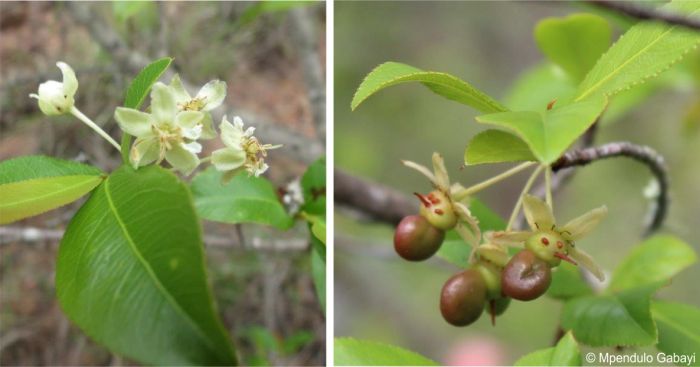
Conservation Status
Status
Due to its restricted occurrence and rarity, it is currently assessed as Critically Endangered (CR) against the South African National Biodiversity Institute (SANBI) Red List of South African Plants criteria. It has not yet been assessed against the global criteria of the International Union for Conservation of Nature (IUCN). This most southern sub-population at the village of Mafukani is facing serious threats due to unsustainable harvesting by traditional medicine collectors and lay persons within the village and the surrounding areas. In view of the current intensity of collecting from this population, it is likely to become extinct in South Africa in the next 15 years if measures to mitigate the situation are not put in place. This population has shown signs of low fruit production and poor seedling recruitment and this is contributing towards the decline of the population numbers. It was observed to have declined by 86% between 1990 and 1997 due to debarking and removal of roots for the medicinal plant trade. In addition to these challenges, the Brackenridgea zanguebarica population is declining due to ring-barking, uprooting and removal of roots.
Distribution and habitat
Distribution description
Brackenridgea zanguebarica is distributed in southeastern Africa, which includes Kenya, Tanzania, Malawi, Zimbabwe, Mozambique, Zambia and South Africa. Within South Africa, just one small population exists in 110 hectares of a protected area, where approximately 400 plants are found in an enclosed nature reserve in the Vhembe District Municipality of Limpopo Province in Mafukani village in the Mutale Local Municipality under the Thengwe Tribal Authority jurisdiction. It is, however, abundant on the eastern side of Zimbabwe and in the northern part of Mozambique. The Mutavhatsindi Nature Reserve and its surroundings have mainly stony, thin and sandy loam soils. In East Africa it is found in deciduous woodland and coastal bushveld.
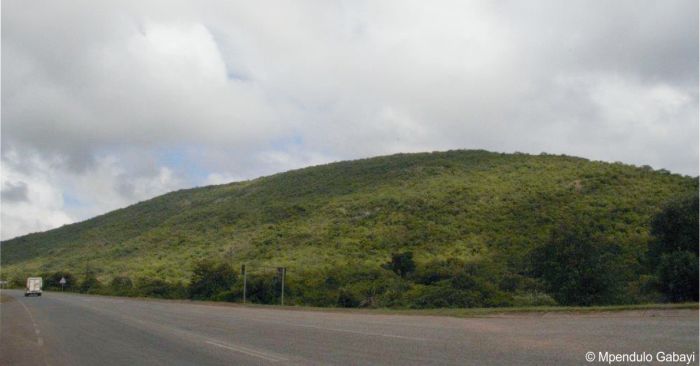
Derivation of name and historical aspects
History
The genus Brackenrigea is named after Mr William Dunlop Brackenridge (1810-1893), an English horticulturist and plant collector in the 1800s. The species name zanguebarica refers to Zanzibar, a small island about 57 km east of mainland Tanzania, where this species also occurs.
Ecology
Ecology
In South Africa it grows on the southwest-facing slopes, at an altitude between 600-900 m above sea level. Climatically falling within semi-arid summer rainfall region with very dry winters. It is said to receive a minimum annual rainfall of 688 mm, most of which falls during the summer months, specifically from October to March, and a minimum annual temperature range of 16-26.5°C. Brackenridgea zanguebarica occurs in the Savanna Biome in the Central Bushveld Bioregion in Soutpansberg Mountain Bushveld with a component of Sourish Mixed Bushveld and the VhaVenda Miombo.
There are no records of any specific pollinators that have been observed for Brackenridgea zanguebarica, however, in the Mutavatsindi Nature Reserve it occurs along with closely related species, such as Ochna pulchra and Ochna natalitia, which are known to be pollinated by bees and butterflies. According to Mr. Ntanganedzeni, who is the senior ranger at Mutavatsindi Nature Reserve, birds have been observed feeding on the seeds of this species, particularly a species of bulbul (Family: Pycnonotidae). Often, this tree hosts nests of wasps between October and December.
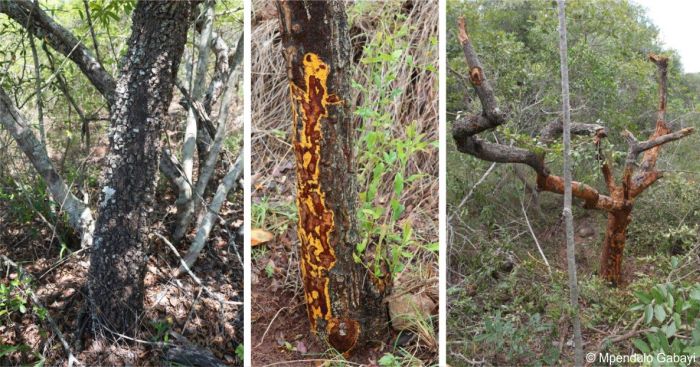
Uses
Use
Brackenridgea zanguebarica commonly called mutavhatsindi, is the most wanted medicinal tree in Limpopo Province. It is used in traditional medicine to treat wounds, worms, amenorrhea, swollen ankles and aching hands, and to protect people and the homestead from evil, to discourage competitors and for other magical purposes.
There are numerous myths surrounding its use. After collecting the root or bark for medicinal purposes, it is prohibited to bring the collected material inside the home yard. One must also not put them anywhere near a woman or allow a woman to touch it. According to Netshiungani and Van Wyk, any woman who touches the collected material of Brackenridgea zanguebarica would suffer the pains of having non-stop menstruation. The local residents also claim that when some of the trees had been damaged during the construction of a road through the area some years ago, the operator of the bulldozer died that same day in an accident.
The traditional medical practitioners believe that Brackenridgea zanguebarica roots or bark should only be collected by a nude person at midnight. It is not allowed to be used as firewood. Anyone who uproots or retrieves its roots or bark without having undergone the prescribed ritual would have a limited lifespan of less than 50 years. If it is a male, such person would become sexually inactive. After getting the roots or bark, one would also be obliged to leave something behind next to the tree like copper coins, tobacco powder or a traditional bracelet. Some of the residents believe that the inhalation of smoke from this tree can cause mental disorder. It is also known for attracting lightning during the rainy season.
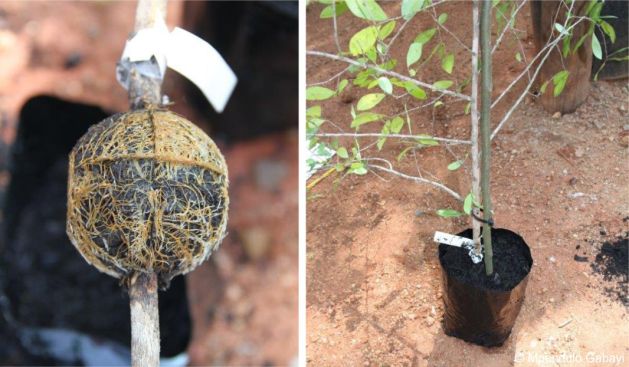
Growing Brackenridgea zanguebarica
Grow
Growing Brackenridgea zanguebarica has proven to be very challenging by both sexual (seeds) and asexual (cuttings) propagation methods. The seeds are suspected to be parasitised, however, there is currently no evidence that proves this theory. The seeds are thought to have physical dormancy, this is due to the hard seed coat that is impermeable by water and oxygen preventing embryo emergence. With regards to the asexual propagation method, rooting is suspected to be affected by temperature, moisture, light and hormonal imbalance to initiate roots.
The only study, by Tiawoun et al. in 2019, has proved that B. zanguebarica is difficult to establish in propagation. Nevertheless, during a pilot study led by Gabayi in 2021, it was proven to be possible to successfully propagate this species by the air layering propagation technique. Use a sharp-edged blade to remove the cambium (bark and cellular tissue) and open an incision of 40-50 mm wide below the node. Scratch around the wood to ensure disconnection of the cambium, and apply hormone powder or gel within the meristematic tissue (an area around the nodes). This propagation technique can only be conducted on-site and not in a controlled environment. Prepare the soil medium, ideally peat moss or sphagnum moss, add a pinch of hydrogel powder mix to keep the soil moist but not wet, and place on a plastic sheet, cover the incision with the plastic full of soil and wrap it around the wound, tie both ends of the plastic tightly with twine and cover with heavy duty aluminium foil. This should be done during the warm and humid season (October to March). This technique has proven to be highly successful, with over 90% success rate, although not reliable due to ongoing plant poaching.
While air layering became a challenge, in parallel, another asexual propagation technique, stem cuttings, was trialed. Cuttings were taken in the early morning while the plants were still in their full vigour. Select one year old growth for cuttings, as they have highly active meristematic tissue. Prepare cuttings of 50-100 mm in length by cutting below the node and make a slant cut above the top node. Prepare a soil medium mix of one part vermiculite and one part sifted fine bark (1:1) or one part perlite and one part sifted fine bark (1:1), mix well and fill in plug trays, use any recommended soil sterilising agent prior to inserting cuttings. Ideally use hormone powder for hardwood and insert in the soil medium. Place theses cuttings on an under-heated bench set at 23-26 °C for two to three weeks. This technique has proven to be moderately successful with at least 30% root development. Further studies are being conducted to improve on this propagation technique.
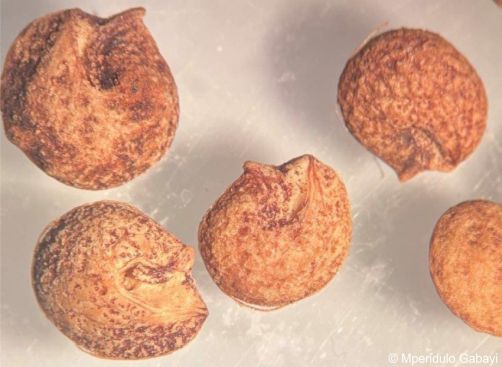
The sexual propagation method (seed germination) proves to be highly challenging due to physical dormancy. To break seed dormancy a number of techniques can be used, such as scarification which involves chemical scarification (softening of the seed coat by using hot water over a period of time, and chemicals) and mechanical scarification (scratching the seed to allow water imbibition and gas exchange as well as use of mycorrhiza fungi). In one of the trials lead by Gabayi in 2023, a soil medium mix of one part compost, two parts sand and one part fine bark (1:2:1) with about 0.5 parts of beneficial fungi on a 3 mm stone chip substrate was prepared. From this propagation method, a poor germination percentage of 1.5% was obtained. Further studies are being conducted to better understand the seed dormancy.
As it stands it remains a challenge to successfully propagate this species, and it is a challenge to keep Brackenridgea zanguebarica actively growing in cultivation.
References
- Coates Palgrave, K. 2002. Trees of southern Africa. Struik, Cape Town.
- Glen, H. 2004. Sappi what’s in a name?. Jacana Media (PTY) Ltd. Johannesburg. 13, 53, 68.
- Mabogo, D.E.N. 1990. The ethnobotany of the Vhavenda. M.Sc. Thesis, University of Pretoria, Pretoria.
- Mutshinyalo, T.T. & Siebert, S.J. 2010. Myth as a biodiversity conservation strategy for the Vhavenda, South Africa. Indiliga: African Journal of Indigenous Knowledge Systems 9(2):151-171.
- Netshiungani, E.N. & Van Wyk, A.E. 1980. Mutavhatsindi: mysterious plant from Venda. Veld & Flora 66:87-90.
- Tiawoun, et al. 2019. Propagation potential for the conservation of Brackenridgea zanguebarica, a critically endangered plant species endemic to Vhembe District in Limpopo Province (South Africa). Journal of Applied Botany and Food Quality 93:59–65.
- Tshisikhawe, M.P. & Van Rooyen, M.W. 2012. Population biology of Brackenridgea zanguebarica in the presence of harvesting. Journal of Medicinal Plants Research 6:5748–5756.
- Tshisikhawe, et al. 2012. An evaluation of the extent and threat of bark harvesting of medicinal plant species in the Venda Region, Limpopo Province, South Africa. Phyton-International Journal of Experimental Botany 81(11):89-100
- Van Wyk, B. & Van Wyk, P. 1997. Field guide to trees of southern Africa. Struik Publishers, Cape Town.
- Williams, V.L. & Raimondo, D. 2022. Brackenridgea zanguebarica Oliv. National Assessment: Red List of South African Plants. https://redlist.sanbi.org/species.php?species=2924-2.
Credits
Mpendulo Gabayi, Kirstenbosch National Botanical Garden
and Thompson Mutshinyalo, Walter Sisulu National Botanical Garden
October 2025
(this article updates and expands on the original published in April 2011)
Acknowledgments: the authors thank Prof Tshisikhawe for the image of Brackenridgea zanguebarica in flower
Plant Attributes:
Plant Type: Shrub, Tree
SA Distribution: Limpopo
Soil type: Sandy, Loam
Flowering season: Spring, Early Summer
PH: Acid
Flower colour: White, Pink
Aspect: Full Sun
Gardening skill: Challenging
Special Features:
Horticultural zones
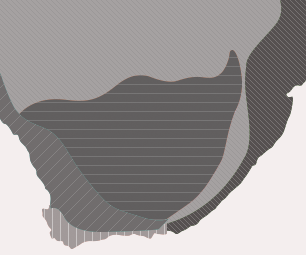






Rate this article
Article well written and informative
Rate this plant
Is this an interesting plant?
Login to add your Comment
Back to topNot registered yet? Click here to register.